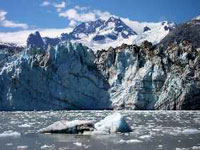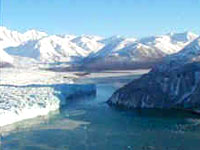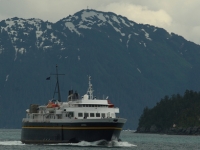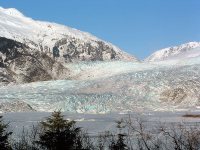City guides


Things to do in The Inside Passage
Alaskan cruises explore the rugged scenery of craggy islands, jutting glaciers and forested coastline, weaving through the Inner Passage, up the Gulf of Alaska and past scores of islands and inlets. Cruise ships traverse a string of coastal cities that include Ketchikan, Skagway, Haines, Sitka and Juneau. Stacked together, their unique atmospheres make a diverse totem pole of cruise ports with Juneau at the top.
Most ships will call port in Juneau, a unique state capital nestled into mountain steps and a narrow inlet. The small city is accustomed to water transportation as no roads lead in or out of the city. Cruise liners are berthed at one of three docks, all within an easy walk of a rustic and charming downtown area. Here, visitors can take a tramway up Mount Roberts to share an eagle's view of the city and landscape below. Visitors can also view scenery with whale watching tours starting from Juneau's waterfront. Those in port for longer stays can catch a ferry to Glacier Bay National Park to see 16 enormous glaciers cut into the land and sea. Others can visit Mendenhall Glacier, close to town.
With no roads connecting the towns the best way to travel is by the Alaska Marine Highway ferry that hops from town to town, or on one of the numerous and very popular cruises that ply the channels. The Alaska Marine Highway is a designated National Scenic Byway and is one of the most beautiful ways to explore Alaska. The deep waters and mild climate provide a prime habitat for whales, sea lions and porpoises, which can often be spotted from the deck. Between the picturesque fishing town of Petersburg and Russian-founded Wrangell is the spectacular Wrangell Narrows that is only 300ft (91m) wide and so shallow in places that the boat is forced into a slalom course of 46 turns to avoid grounding on the channel bottom. Frederick Sound is a prime whale sighting area.

Glacier Bay National Park
When the early explorers and pioneers of the 18th century sailed this way, Glacier Bay was hidden under a huge sheet of solid ice, more than 4,000ft (1,219m) thick and up to 20 mil…
Glacier Bay National Park
When the early explorers and pioneers of the 18th century sailed this way, Glacier Bay was hidden under a huge sheet of solid ice, more than 4,000ft (1,219m) thick and up to 20 miles (32km) wide. Today the branching 65-mile (105km) long fjord is the work of the fastest-receding glacier on earth; the melting ice of the Grand Pacific Glacier opening up a spectacular carved terrain of steep rock walls lining deep-water fjords.
Sliding out of the mountains are 16 active glaciers that fill the sea with different shaped icebergs, creating the icy blue landscape that is world-renowned. At the head of the fjord is the massive ice wall of the Grand Pacific Glacier, slowly melting and sculpting the still-unfinished land as it backs away from the sea, a natural work of art in progress.
An added attraction is the variety of aquatic life including humpback whales, sea otters, seals and porpoises, while bears, moose, mountain goats and many species of birds inhabit the land. This rugged landscape can only be accessed by boat or small plane as most of the park is made up of water. As opportunities to see this huge wilderness are limited, facilities can be crowded, especially on the tour boats.
Activities are somewhat expensive, and wildlife sightings cannot be guaranteed. Gustavus is the small settlement that services the park, but the park headquarters is at Bartlett Cove from where boats can be arranged or alternate means provided to enjoy the park experience. Kayaking or camping in the backcountry, ranger-led programmes or walks, hiking and fishing are all available.
Website www.nps.gov/glba

Hubbard Glacier
There is surely no more spectacular experience on the planet than to witness the calving of a titanic glacier. A stopover to watch nature's incredible marvel, the Hubbard Glacier, …
Hubbard Glacier
There is surely no more spectacular experience on the planet than to witness the calving of a titanic glacier. A stopover to watch nature's incredible marvel, the Hubbard Glacier, in action as the high wall of ice thickens and advances towards the Gulf of Alaska is one of the unforgettable moments that makes thousands of holidaymakers opt for an Alaskan cruise every year. The Hubbard Glacier is the largest tidewater glacier in North America, beginning its 75-mile (121km) journey to the sea on the tallest mountain in Canada, Mount Logan, and finally shedding tons of its bulk in awesome ice falls across the six-mile (10km) wide head of Yakutat Bay. Every day cruise liners pull in, their passengers bundled up in their warmest clothing and festooned with cameras and binoculars, as they hang over the deck rails to witness the stunning sight of the luminous blue-green ice wall as it creeps inexorably forward. Those who visit at the right time could be fortunate enough to see one of nature's most awesome events, when a chunk of ice cracks and falls thunderously from the wall into the ocean as the mighty glacier calves, startling the seals basking on ice floes.

Alaskan Ferry
Large cruise ships regularly travel to major ports in Alaska but a better idea for those who prefer a more intimate option is the Alaskan Ferry. Departing from Bellingham, Washingt…
Alaskan Ferry
Large cruise ships regularly travel to major ports in Alaska but a better idea for those who prefer a more intimate option is the Alaskan Ferry. Departing from Bellingham, Washington, these large ferries bounce through the major coastal towns of Canada and The Gulf of Alaska before stretching to the Alaskan Peninsula. The landscapes are staggering, revealing hundreds of craggy forest-dense islands and coastlines. Eagles, killer whales, bears and other hardy wildlife are all part of the view. The months of operation are May to September, when the weather is bearable and sunshine illuminates most of the evening hours. Costs vary greatly depending on the length of the voyage and style of accommodation. Most ferries rent out cabins but those in tune with Alaska's pioneer spirit can pitch a tent on deck or just use a blanket.

Mendenhall Glacier
The most popular attraction in Juneau is the Mendenhall Glacier, located just 12 miles (19km) from the downtown area. Originally known as Sitaantaagu ('the Glacier Behind the Town'…
Mendenhall Glacier
The most popular attraction in Juneau is the Mendenhall Glacier, located just 12 miles (19km) from the downtown area. Originally known as Sitaantaagu ('the Glacier Behind the Town') by the Tlingits, it was renamed in honour of Thomas Corwin Mendenhall, a noted American scientist, in 1892. He was responsible for surveying the international boundary between Canada and Alaska. The Mendenhall Glacier is 1.5 miles (3km) wide, and calves into its own lake. Visitors have several options for seeing the Mendenhall Glacier. It can be viewed from the Mendenhall Glacier Visitor Center, which includes a recreation area that's good for viewing black bears; or visitors can hike to the glacier via the Mendenhall Glacier West Glacier Trail, which takes roughly five hours both ways. It's a good idea for visitors to hike with a guide, and bring crampons if they want to hike on the glacier itself. As an added option, several businesses in Juneau offer helicopter rides to the glacier itself, although these are fairly expensive.


